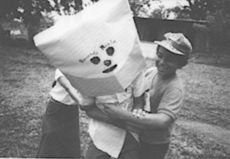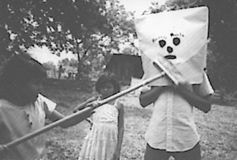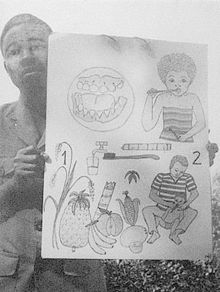Hesperian Health Guides
Part 2: Making Learning Exciting, Visual and Fun
HealthWiki > Where There Is No Dentist > Chapter 3: Teaching Children at School > Part 2: Making Learning Exciting, Visual and Fun
Tell a story about food or teeth. For example, tell a story about why a wild cat’s teeth are different in shape from a goat’s teeth. Stories are an excellent way to learn, both for the storyteller and for those listening. Leave time at the end to discuss the story and to introduce new information. See an example of storytelling.
Make up a play or drama about nutritious food or clean teeth. Show it later to the community.
The play should be about looking for an answer to a real problem. If the children invent the play, they will have to think, plan, and solve problems. A play also helps children learn how to talk with and teach others.
 |
 |
| These school children in Nicaragua are doing a play about cavities. On the left, germs and sweet food are combining and trying to make a hole in the “tooth.” But a giant toothbrush (right) beats them away! | |
Do a demonstration using local resources.

Try, for example, the "tooth in the Coca-Cola" test..
Puzzles can help school children discover answers for themselves. You can make your own. The best puzzles are with words that the students know and can use easily.
| EXAMPLE (for younger children just learning to read) Try to find these words: | |
 |
 |
| As you find each word, put a √ beside it. |
An older child can try to find important words that are more difficult.

Spell some of the words diagonally (slanted). It will make the puzzle harder.
You can use pictures on posters, flip charts, and on flannel-boards.
Pictures that school children draw themselves are best. They learn simply by drawing them. Also, school children will draw local people and local experiences, and the people will understand their pictures better than the ones sent from a central office far away.
Photographs of local people and events are also good. If there is a photography club in a local secondary school, have them take some pictures for you. They may even print the photographs larger so that you can use them as posters.

Ask the children to make pictures big enough so that a person can stand far away and see them easily.
Let each child carry her poster home to show her family and friends.
Hang up other posters in the store, church, or other places where people will see them.
Pictures can be made to stick to cloth and then used to tell a story. Cover a board with a piece of flannel cloth or a soft blanket, to make a flannel-board. For more ideas on flannel-boards, see pages 11-15 to 11-19 Helping Health Workers Learn.

Mix some flour and water to make glue. Then glue a strip of sandpaper to the back of each picture. The sandpaper sticks to the cloth and lets you place the picture where you want on the cloth.
Let the child use her pictures and cloth outside of the school, to show her story to family and friends.
Flip charts are excellent for telling a story with pictures. Often, people can guess what the story is about just from the pictures. When showing the pictures on a flip chart, ask as many questions as you can, to get the people to tell you the story.


Here a health worker from Mozambique is holding a flip chart with pictures about care of teeth and gums. There are no words with the pictures.
But he can read a short message written on the back of the page before. There are also examples of questions to ask.
This way, anyone who can read can tell the flip chart story to others.
| Find a way to attach the sheets of heavy paper. Here are two ways: | |
 |
 |


